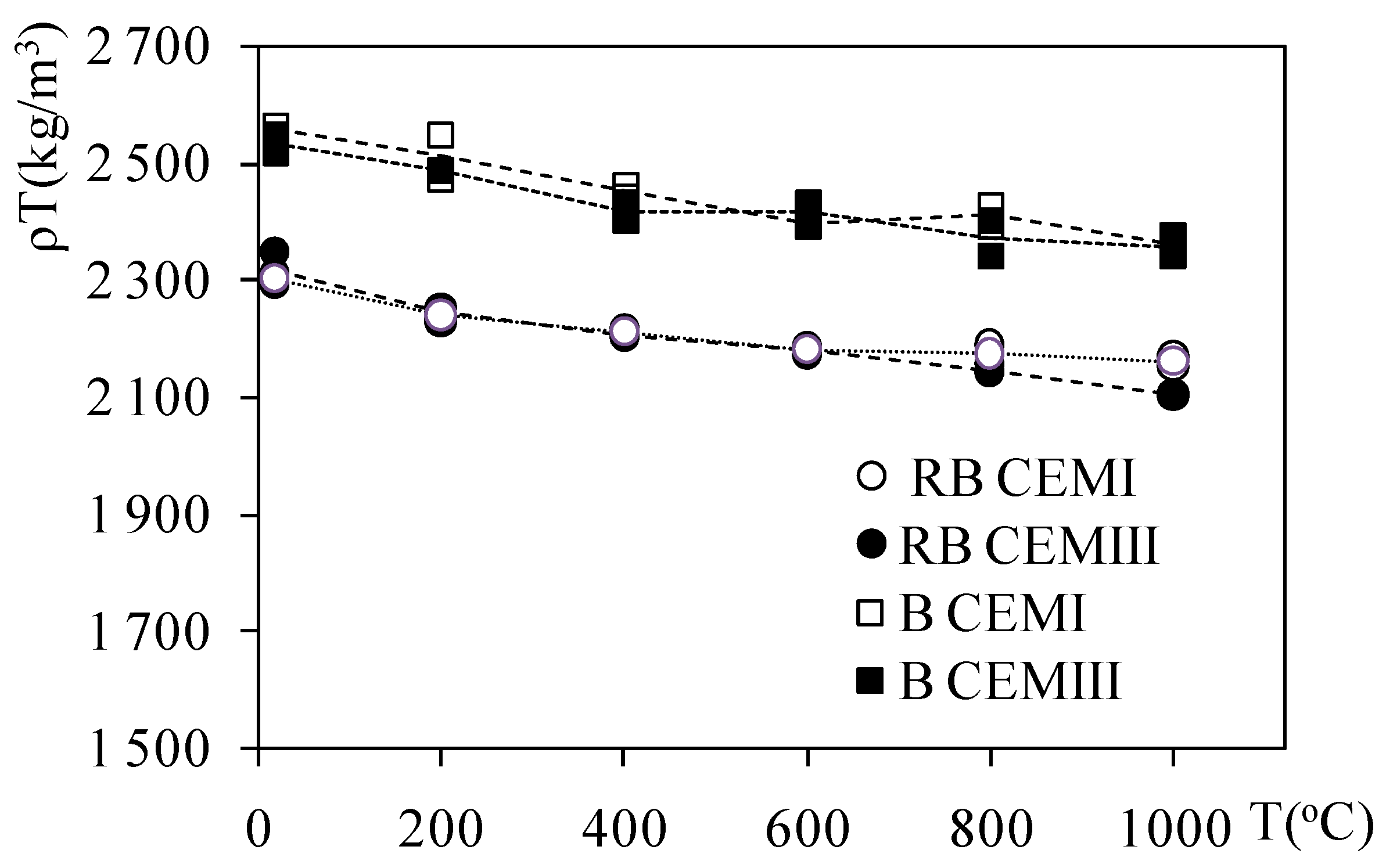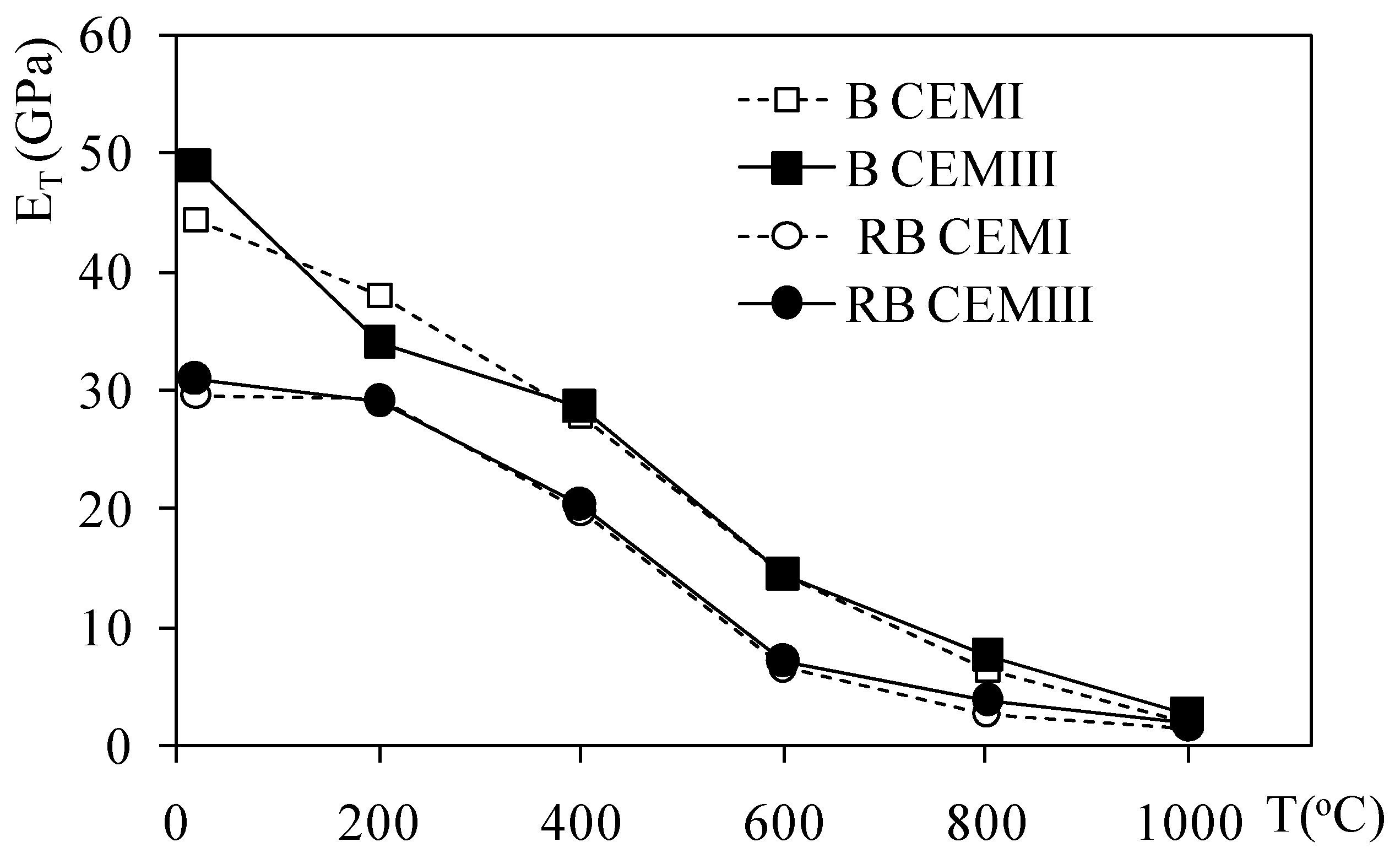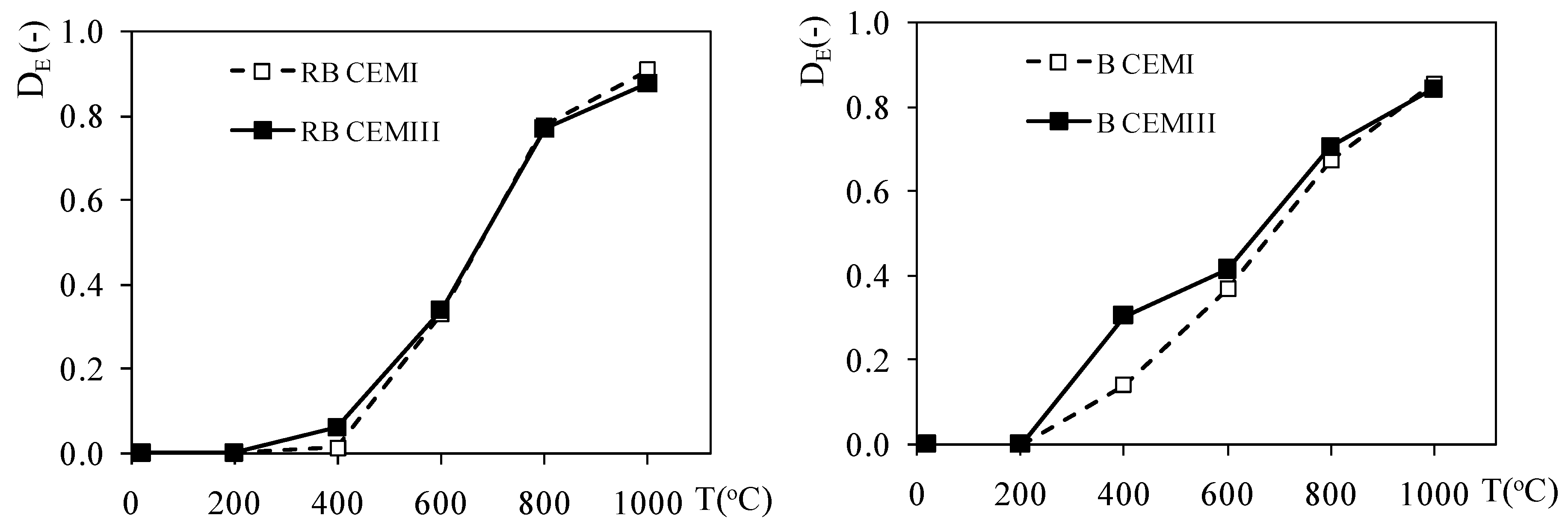Effect of Cement Type on the Mechanical Behavior and Permeability of Concrete Subjected to High Temperatures
Abstract
:1. Introduction
2. Materials, Specimen Preparation, Curing, and Heating
3. Testing Procedures
3.1. Concrete Permeability
- Q: the measured gas flow intensity Q = V/t (m3/s);
- V: gas volume (m3)
- t: time (s)
- Pa: atmospheric pressure (1 bar = 105 Pa);
- P: absolute pressure (Pa);
- A: cross section area of the specimen (m2);
- η: nitrogen viscosity; η = 17.15 (Pa⋅s);
- L: thickness of the specimen (m).
3.2. Mechanical Tests
4. Test Results and Discussion
4.1. Initial Properties
4.2. Evolution of Bulk Density with Temperature
4.3. Evolution of Compressive Strength and Splitting Tensile Strength with Temperature Exposure
4.4. Relationship between Stress and Strain, and the Modulus of Elasticity Evaluation
4.5. Heated Concrete Permeability Evolution
4.6. Permeability vs. High Temperature Damage Factor
5. Conclusions
- Type of cement influences compressive strength and permeability of 90 day concrete. Concretes with CEMIII presented lower permeability and higher compressive strength for both basalt and riverbed aggregate concretes;
- High temperature exposure strongly influences the mechanical and physical properties of concretes, and the damage to concrete increases with exposure temperature. A temperature increase leads to the reduction of strength and modulus of elasticity. The splitting tensile strength decrease is more pronounced than the compressive strength evolution.
- Minor differences between the mechanical properties of heated CEMI and CEMIII concretes were observed. The bulk density values, as well as the mechanical properties fcT, ftT and ET, were very close or the differences were within the range of measurement error or the scatter of results of the properties tested;
- The nature of the aggregate has a dominant influence on the material physical density and mechanical properties of the tested concretes. The compressive and tensile strengths depend on the aggregate nature for temperature up to 400 °C; above this temperature level, similar values of strength are observed;
- The decrease in the mechanical properties is the result of progressive cement paste damage due to dehydration and chemical changes in the cement paste. Moreover, crack development due to the thermal mishmash of aggregate and cement paste results in nonlinear behavior of heated concretes;
- The course of changes of the relative value in the elastic modulus for all the concretes investigated was very similar, except for the temperature of 400 °C. The riverbed aggregate concretes RB CEMI and RB CEMIII hada lower damage parameter than that observed for basalt aggregate concretes (B CEMI and B CEMIII) at this temperature. For 200, 600, 800, and 1000 °C, the damage levels were similar;
- Important changes of up to six orders of magnitude were observed in permeability values following heating. However, the differences between the concretes could not be considered as significant. Indeed, CEMIII concretes presented slightly lower values of permeability in comparison with the CEMI ones in whole range of temperatures. On the other hand, basalt aggregate-based concretes have slightly lower permeability than riverbed ones. Concretes with CEMI: riverbed 1.2 × 10−17 vs. basalt 0.7 × 10−17; concretes with CEMIII: riverbed 0.99 × 10−17 vs. basalt CEMIII 0.53 × 10−17. That difference was be explained by lower permeability of basalt aggregate itself. This relation was also observed for the temperatures of 200, 400, and 600 °C;
- Analysis of the results allowed the formulation of the constitutive exponential law, presenting the relationship between the permeability of concrete and damage, which is valid up to 600 °C.
- It can be considered that heating induces damage, which may be represented by changes in the initial modulus of elasticity, that depends to a small degree on the type of cement. In this range of damage, the effects of aggregate type are also non-significant.
Author Contributions
Funding
Conflicts of Interest
References
- Pal, S.C.; Mukherjee, A.; Pathak, S.R. Investigation of hydraulic activity of ground granulated blast furnace slag in concrete. Cem. Concr. Res. 2003, 33, 1481–1486. [Google Scholar] [CrossRef]
- Topçu, I.B. High-volume ground granulated blast furnace slag (GGBFS) concrete. In Eco-Efficient Concrete; Pacheco-Torgal, F., Jalali, S., Eds.; Elsevier: Cambridge, UK, 2013; pp. 218–240. [Google Scholar]
- Lura, P.; van Breugel, K.; Maruyama, I. Effect of curing temperature and type of cement on early-age shrinkage of high-performance concrete. Cem. Concr. Res. 2001, 31, 1867–1872. [Google Scholar] [CrossRef]
- Shumuye, E.D.; Zhao, J.; Wang, Z. Effect of fire exposure on physico-mechanical and microstructural properties of concrete containing high volume slag cement. Constr. Build. Mater. 2019, 213, 447–458. [Google Scholar] [CrossRef]
- Farzampour, A. Compressive Behavior of Concrete under Environmental Effects. In Compressive Strength of Concrete; IntechOpen: London, UK, 2019; pp. 1–12. [Google Scholar]
- Mindeguia, J.-C.; Hager, I.; Pimienta, P.; Borderie, C.L.; Carré, H. Parametrical study of transient thermal strain of high performance concrete. Cem. Concr. Res. 2013, 48, 40–52. [Google Scholar] [CrossRef]
- Hager, I. Behaviour of cement concrete at high temperature. Bull. Pol. Acad. Sci. Tech. Sci. 2013, 61, 145–154. [Google Scholar] [CrossRef]
- Pimienta, P.; Jansson McNamee, R.; Mindeguia, J.-C. (Eds.) Physical Properties and Behaviour of High-Performance Concrete at High Temperature. State-of-the-Art Repport of the RILEM Technical Committee HPB-227; Springer: Cham, Switzerland, 2019; pp. 1–130. [Google Scholar]
- Gawin, D.; Alonso, C.; Andrade, C.; Majorana, C.E.; Pesavento, F. Effect of damage on permeability and hygro-thermal behaviour of HPCs at elevated temperatures: Part 1. Experimental results. Comput. Concr. 2005, 2, 189–202. [Google Scholar] [CrossRef]
- Hager, I.; Tracz, T.; Śliwiński, J.; Krzemień, K. The influence of aggregate type on the physical and mechanical properties of high-performance concrete subjected to high temperature. Fire Mater. 2016, 40, 668–682. [Google Scholar] [CrossRef]
- Xing, Z.; Beaucour, A.-L.; Hebert, R.; Noumowe, A.; Ledesert, B. Influence of the nature of aggregates on the behaviour of concrete subjected to elevated temperature. Cem. Concr. Res. 2011, 41, 392–402. [Google Scholar] [CrossRef]
- Mindeguia, J.-C.; Pimienta, P.; Carré, H.; Borderie, C.L. On the influence of aggregate nature on concrete behaviour at high temperature. Eur. J. Environ. Civ. Eng. 2012, 16, 236–253. [Google Scholar] [CrossRef]
- Ju, Y.; Tian, K.; Liu, H.; Reinhardt, H.-W.; Wang, L. Experimental investigation of the effect of silica fume on the thermal spalling of reactive powder concrete. Constr. Build. Mater. 2017, 155, 571–583. [Google Scholar] [CrossRef]
- Al-Jabri, K.S.; Waris, M.B.; Al-Saidy, A.H. Effect of aggregate and water to cement ratio on concrete properties at elevated temperature. Fire Mater. 2016, 40, 913–925. [Google Scholar] [CrossRef]
- Hager, I.; Pimienta, P. Mechanical properties of HPC at high temperatures. In Fire Design of Concrete Structures: What Now? What Next? Gambarova, P.G., Felicetti, R., Meda, A., Riva, P.Eds.; Starrylink: Brescia, Italy, 2004; pp. 95–100. [Google Scholar]
- RILEM TC: Test methods for mechanical properties of concrete at high temperatures, Recommendations, Part 3: Compressive strength for service and accident conditions. Mater. Struct. 1995, 28, 410–414. [CrossRef]
- Asamoto, S.; Yuguchi, R.; Kurashige, I.; Chun, P.J. Effect of high temperature at early age on interfacial transition zone and material properties of concrete. In Proceedings of the RILEM Proc. 121 618 SynerCrete18 Int. Conf. Interdiscip. Approaches Cem.-Based Mater. Struct. Concr, Funghal, Portugal, 24–26 October 2018; pp. 683–688. [Google Scholar]
- Śliwiński, J.; Tracz, T.; Zdeb, T. Influence of selected parameters of cement concrete composition on its gas permeability. In Recent Advances in Civil Engineering: Building Materials and Building Physics; Śliwiński, J., Politech, K., Eds.; Elsevier: Cracow, Poland, 2015; Volume 479, pp. 97–119. [Google Scholar]
- Kalifa, P.; Menneteau, F.D.; Quenard, D. Spalling and pore pressure in HPC at high temperature. Cem. Conc. Res. 2000, 30, 1915–1927. [Google Scholar] [CrossRef]
- Kalifa, P.; Chéné, G.; Gallé, C. High-temperature behaviour of HPC with polypropylene fibers: From spalling to microstructure. Cem. Conc. Res. 2001, 31, 1487–1499. [Google Scholar] [CrossRef]
- Mindeguia, J.C.; Pimienta, P.; Noumowe, A.; Kanema, M. Temperature, pore pressure and mass variation of concrete subjected to high temperature—Experimental and numerical discussion on spalling risk. Cem. Conc. Res. 2012, 40, 477–487. [Google Scholar] [CrossRef]
- Lo Monte, F.; Felicetti, R.; Meda, A.; Bortolussi, A. Assessment of concrete sensitivity to fire spalling: A multi-scale experimental approach. Constr. Build. Mater. 2019, 212, 476–485. [Google Scholar] [CrossRef]
- Mróz, K.; Hager, I. Causes and mechanism of concrete spalling under high temperature caused by fire. Cem. Wap. Bet. 2017, 6, 445–456. [Google Scholar]
- Zheng, W.Z.; Hou, X.M.; Shi, D.S.; Xu, M. Experimental study on concrete spalling in prestressed slabs subjected to fire. Fir. Saf. J. 2010, 45, 283–297. [Google Scholar] [CrossRef]
- Zhang, Y.; Zeiml, M.; Pichler, C.H.; Lackner, R. Model-based risk assessment of concrete spalling in tunnel linings under fire loading. Eng. Struct. 2014, 77, 207–215. [Google Scholar] [CrossRef]
- Gawin, D.; Pesavento, F.; Guerrero Castells, A. On reliable predicting risk and nature of thermal spalling in heated concrete. Arch. Civ. Mech. Eng. 2018, 18, 1219–1227. [Google Scholar] [CrossRef]
- Karahan, O. Transport properties of high volume fly ash or slag concrete exposed to high temperature. Constr. Build. Mater. 2017, 152, 898–906. [Google Scholar] [CrossRef]
- Choinska, M.; Khelidj, A.; Chatzigeorgiou, G.; Pijaudier-Cabot, G. Effects and interactions of temperature and stress-level related damage on permeability of concrete. Cem. Concr. Res. 2007, 37, 79–88. [Google Scholar] [CrossRef] [Green Version]
- Hager, I.; Tracz, T. The impact of the amount and length of fibrillated polypropylene fibers on the properties of HPC exposed to high temperature. Arch. Civ. Eng. 2010, 1, 57–68. [Google Scholar] [CrossRef]
- Schneider, U.; Herbst, H.J. Permeabilität und Porosität von Betonbeihohen Temperaturen; Deutscher Ausschuss für Stahlbeton: Berlin, Germany, 1989; Volume 403, pp. 1–140. [Google Scholar]
- Kollek, J.J. The determination of the permeability of concrete to oxygen by the Cembureau method—RILEM recommendation. Mater. Struct. 1989, 22, 225–230. [Google Scholar] [CrossRef]
- EN 12390-3 Testing hardened concrete—Part 3: Compressive Strength of Test Specimens; British Standards Institution (BSI): London, UK, 2019; pp. 1–24.
- EN 12390-6 Testing hardened concrete—Part 6: Tensile Splitting Strength of Test Specimens; British Standards Institution (BSI): London, UK, 2009; pp. 1–14.
- Gawin, D.; Majorana, C.; Pesavento, F.; Schrefler, B. A fully coupled multiphase FE model of hygro-thermo-mechanical behaviour of concrete at high temperature. In Computational Mechanics, New Trends and Applications, Proceedings of the 4th World Congress on Computational Mechanics, Buenos Aires, Argentina, 29 June–2 July 1998; Onate, E., Idelsohn, S.R., Eds.; CIMNE: Barcelona, Spain, 1998; pp. 1–19. [Google Scholar]
- de Borst; et al. On modelling of thermo-mechanical concrete for the finite element analysis of structures submitted to elevated temperatures. In Fract. Mech. Concr. Struct; de Borst; et al. Swets&Zeitlinger: Lisse, Nedherlands, 2001; Volume 1, pp. 271–278. [Google Scholar]
- Mazars, J. Application de la Mecanique de L’endommagement au Comportament non Lineaire et la Rupture du Beton de Structure. Ph.D. Thesis, Universite de Paris, Paris, France, 1984. [Google Scholar]
- Gawin, D.; Pesavento, F.; Schrefler, B.A. Simulation of damage-permeability coupling in hygro-thermo-mechanical analysis of concrete at high temperature. Commun. Numer. Methods Eng. 2002, 18, 113–119. [Google Scholar] [CrossRef]
- Pijaudier-Cabot, G.; Dufour, F.; Choinska, M. Damage and Permeability in Quasi-brittle Materials: From Diffuse to Localized Properties. In Multiscale Modeling of Heterogenous Materials: From Microstructure to Macro-scale Properties; Wiley-ISTE: London, UK, 2010; pp. 277–292. [Google Scholar]









| Component | CEMI 42.5 R | CEMIII/A 42.5 N |
|---|---|---|
| SiO2 | 18.6 | 30.0 |
| Al2O3 | 5.3 | 6.2 |
| Fe2O3 | 2.9 | 1.7 |
| CaO | 62.7 | 50.3 |
| MgO | 1.50 | 4.98 |
| SO3 | 3.22 | 2.41 |
| Na2O | 0.19 | 0.37 |
| K2O | 0.96 | 0.70 |
| eqNa2O | 0.82 | 0.83 |
| Cl− | 0.060 | 0.016 |
| Portland clinker content GGBFS Gypsum | 96 0 4 | 45 53 2 |
| Parameter | CEMI 42.5 R | CEMIII/A 42.5 N |
|---|---|---|
| Specific area (Blaine method), m2/kg True density, g/cm3 | 340 3.09 | 465 2.97 |
| Setting time, minutes -initial -final | 199 270 | 221 266 |
| Parameters | CEMI 42.5 R | CEMIII/A 42.5 N |
|---|---|---|
| Compressive strength, MPa -after 2 days -after 28 days | 29.3 55.1 | 13.7 50.7 |
| Concrete | Unit | B CEMI | B CEMIII | RB CEMI | RB CEMIII | |
|---|---|---|---|---|---|---|
| Component | ||||||
| CEM I 42.5 R | kg/m3 | 482 | 482 | |||
| CEM III/A 42.5 N | kg/m3 | 482 | 482 | |||
| Water | dm3/m3 | 145 | ||||
| w/c ratio | – | 0.30 | ||||
| Riverbed quartz sand 0–2 mm RB, riverbed 2–8 mm RB, riverbed 8–16 mm B, basalt 2–8 mm B, basalt 8–16 mm | kg/m3 | 662 – – 709 648 | 662 – – 709 648 | 663 610 558 – – | 663 610 558 – – | |
| Plasticizer BASF BV 18 Superplasticizer BASF Glenium SKY 591 | % mc | 0.90 2.20 | 0.90 2.35 | 0.90 2.20 | 0.90 2.35 | |
| Cement paste content Mortar content Coarse aggregate content | dm3/m3 | 300 550 450 | ||||
| Slump (consistency) | mm | 120–150 | ||||
| Air content in concrete mix | % vol. | 1.7–2.0 | ||||
| Property | Unit | B CEMI | B CEMIII | RB CEMI | RB CEMIII |
|---|---|---|---|---|---|
| B Basalt Coarse Aggregate | RB Riverbed Coarse Aggregate | ||||
| Bulk density ρo20°C | kg/m3 | 2558.8 | 2533.2 | 2300.7 | 2315.6 |
| Compressive strength fc20°C | MPa | 84.9 | 96,2 | 77.0 | 87.4 |
| Splitting tensile strength ft20°C | MPa | 6.2 | 6.9 | 6.0 | 5.6 |
| Modulus of elasticity E20°C | GPa | 44.4 | 48.9 | 30.6 | 29.7 |
| Permeability k20°C | m2 | 0.70 × 10−17 | 0.52 × 10−17 | 1.20 × 10−17 | 1.00 × 10−17 |
© 2019 by the authors. Licensee MDPI, Basel, Switzerland. This article is an open access article distributed under the terms and conditions of the Creative Commons Attribution (CC BY) license (http://creativecommons.org/licenses/by/4.0/).
Share and Cite
Hager, I.; Tracz, T.; Choińska, M.; Mróz, K. Effect of Cement Type on the Mechanical Behavior and Permeability of Concrete Subjected to High Temperatures. Materials 2019, 12, 3021. https://doi.org/10.3390/ma12183021
Hager I, Tracz T, Choińska M, Mróz K. Effect of Cement Type on the Mechanical Behavior and Permeability of Concrete Subjected to High Temperatures. Materials. 2019; 12(18):3021. https://doi.org/10.3390/ma12183021
Chicago/Turabian StyleHager, Izabela, Tomasz Tracz, Marta Choińska, and Katarzyna Mróz. 2019. "Effect of Cement Type on the Mechanical Behavior and Permeability of Concrete Subjected to High Temperatures" Materials 12, no. 18: 3021. https://doi.org/10.3390/ma12183021






